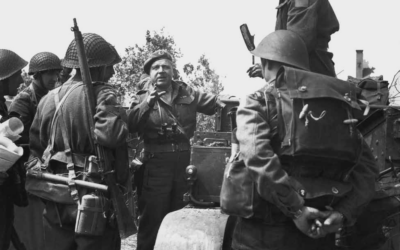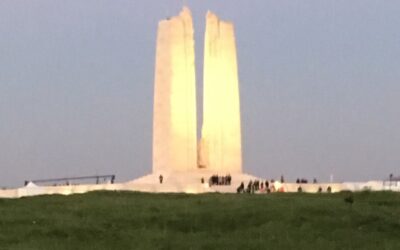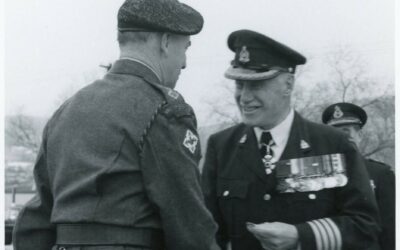Canadian troops were at the forefront during momentous events in 1944. Two British Columbia units, the Westminster Regiment (Motor), and the 9th Canadian Armoured Regiment (British Columbia Dragoons), of the 5th Canadian Armoured Division thrust through the breach in the Adolph Hitler Line in May 1944. Okanagan troops were there, and this is their story.
After the Allies captured Sicily and advanced up the ‘boot’ of Italy they found two primary routes northwards. The Liri Valley was a key route from Naples to Rome on the west side of the Apennines mountains and the Foggia to San Marino route on the east side. Both were blocked by German defensive lines such as the Gustav Line based on the famous Abbey of Monte Cassino and the Gari River north of Naples. American and British forces had landed on the beaches of Anzio south of Rome behind German lines on January 22, 1944, but were trapped. Meanwhile the British 8th Army, with the 1st Canadian Infantry Division [1CID], were engaged around Ortona in the east. By the end of April, a truly international force comprised of American, Australian, British, Canadian, Greek and Turkish Cypriots, French, Gurkhas, Indians, and Punjabis, New Zealanders, Polish, Rhodesians, and South Africans to name a few, crowded between the west coast and the Apennines Mountain spine of Italy pushing to link up with the American/British Anzio beachhead.
The narrow 30 km (about 18.64 mi) long valley between highlands east and west was intersected by streams with steep banks; extensive agricultural developments such as vineyards and orchards on rolling terrain; extremely limited roads described by inadequate maps; and was defended by machine gun bunkers, mines, anti-tank gun turrets called Panzerturms, and infantry. The best road, Highway 6 above the valley, from Cassino to Acre and then down to Ceprano and north towards Rome, was in the British sector.
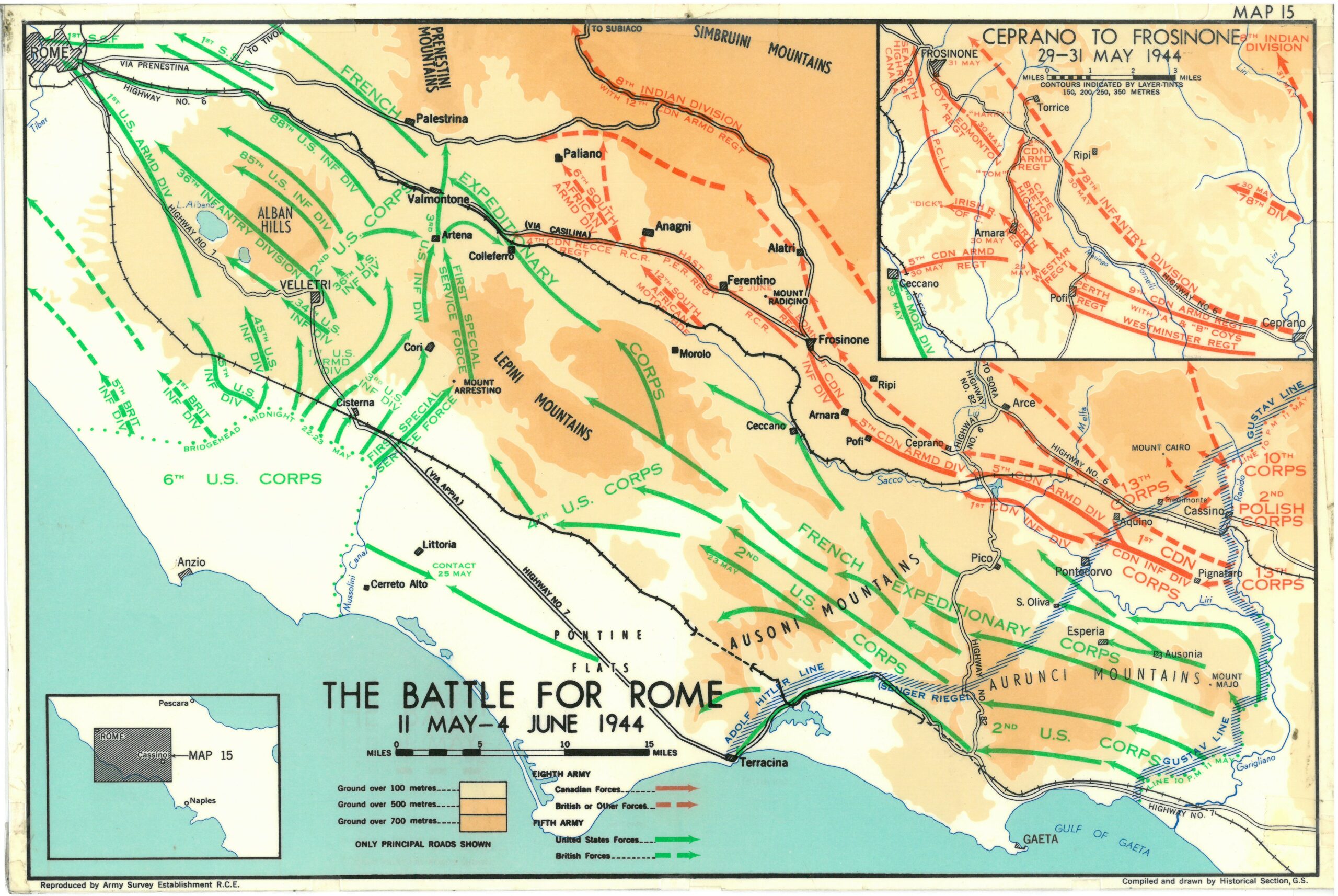 BCD-C-522-C1
BCD-C-522-C1
The first phase of the Canadian fight in May 1944 was to develop the breach through the Gustav Line, opened by the 4th and 78th British Divisions and the 8th Indian Division on May 15 from Sant Angelo to Pignataro. 1st Canadian Division advanced through to the Adolph Hitler Line while the 5th Canadian Armoured Division [5CAD] was moving up. The 9th Canadian Armoured Regiment (British Columbia Dragoons) [9th CAR(BCD)] was in the 5th Canadian Armoured Brigade of this division. Their first action started on 24 May 1944.
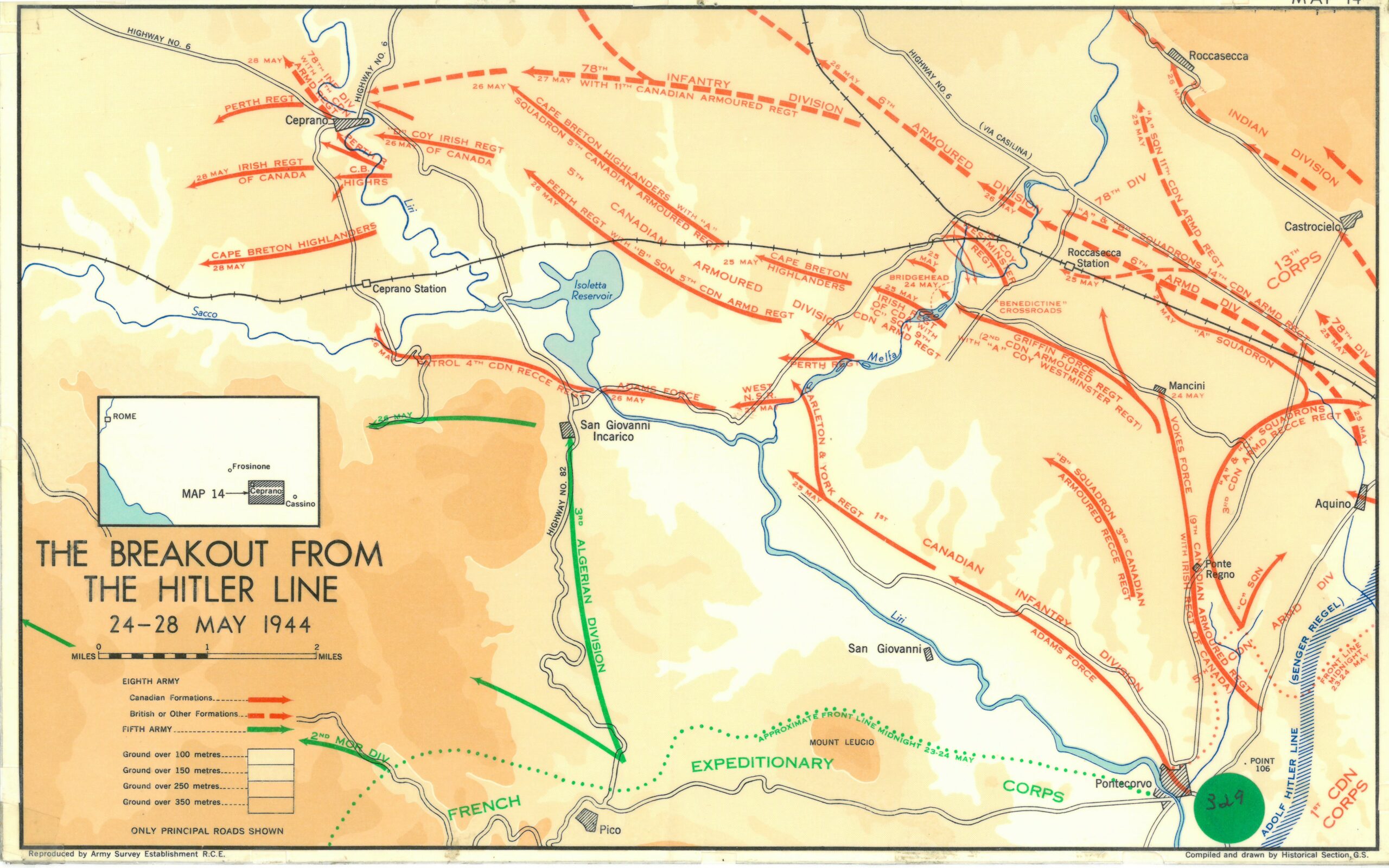 BCD-C-522-H2
BCD-C-522-H2
A combat team, called ‘Vokes Force’ named after BCD Lieutenant-Colonel F. A. Vokes, that consisted of infantry from the Irish Regiment of Canada, BCD tanks, and guns of the 98th self-propelled anti-tank battery, was to pass through a breach in the Adolph Hitler Line of German defences across the Liri Valley south of Rome. The breach, made by units of the 1st Canadian Infantry Division, was between the towns of Aquino and Pontecorvo. The breakout was called Operation Chesterfield.
The Recce, or Reconnaissance Troop leads off towards the start line ‘Vermouth’ through a gully with the Infantry riding on the tanks followed by C Squadron [Sqn], then B and A Sqns. They formed up with B Sqn on the left, C Sqn on the right and A Sqn in reserve to advance towards the town of Mancini, objective ‘Brandy,’ through enemy shelling, infantry, and anti-tank fire.
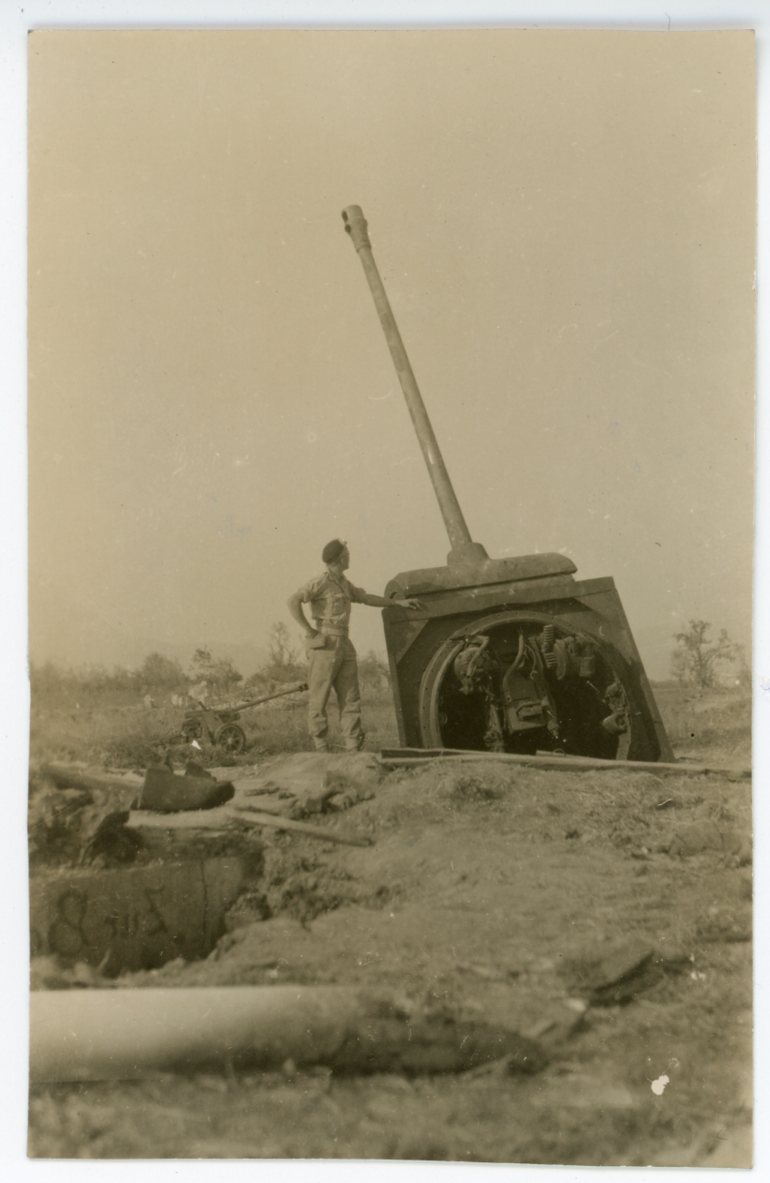
The orders were to wait for other units to occupy ‘Brandy’ before moving towards their next objective called ‘Kummel.’ They encountered close rolling country that limited their visual range and support wires in vineyards that could decapitate crew commanders standing in their turrets or the soldiers riding on the tanks and tangle the tracks of the tanks. When ‘Brandy’ was occupied, the BCDs pressed on towards ‘Kummel.’
‘Kummel’ was where ‘Griffin Force,’ consisting of machine gun and anti-tank platoons of the Westminster Regiment (Motor), known as Westies; tanks of the Lord Strathcona’s Horse; and self-propelled anti-tank guns of the 91st Battery; would launch their assault across the Melfa River. The river was shallow with steep embankments covered by enemy guns, mortars, and artillery. No bridge existed so a suitable place to ford the river with vehicles was created under fire. This was held at great peril by a small group of Westminster soldiers and Strathcona tanks. That included two Vernon men, Privates Walter Drummond and Melvin Jackson, in the Westies. BCDs of C Sqn and more Westies tried three times on May 25 to crash through German self-propelled anti-tank guns and infantry to finally relieve them and expand the bridgehead. 27 Strathcona tanks were lost in this action. Another Okanagan soldier, Lance/Sergeant Len Bailey of Winfield, earned a Military Medal decoration for his work in the Westies’ Scout and Sniper platoon. C Sqn lost seven of fourteen tanks, three of four troop officers and 18 troops as casualties with five killed. They destroyed one Panther turret Panzerturm, a Panzer Mk IV, two anti-tank guns and two self-propelled anti-tank guns.
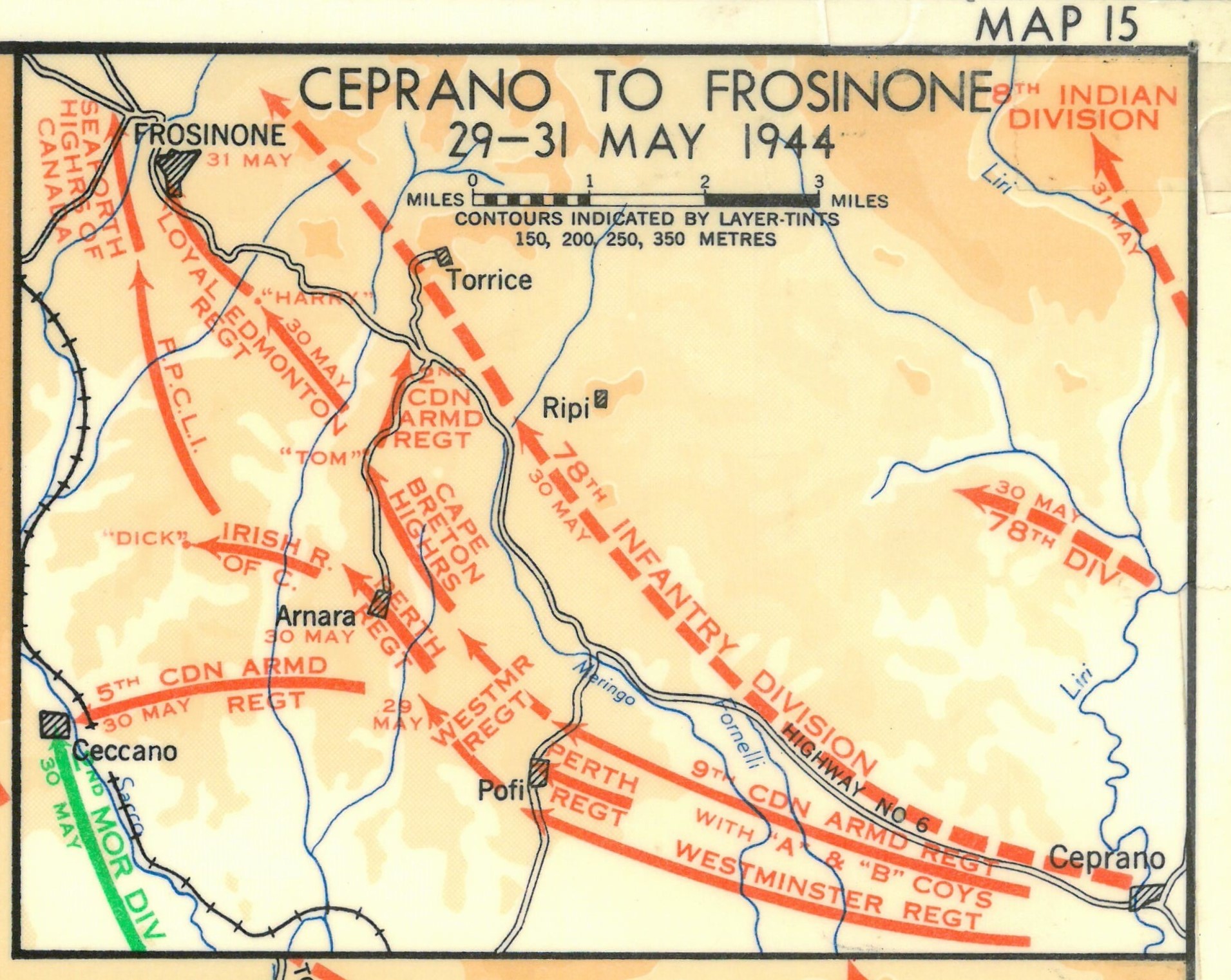
After crossing the Melfa River, the BCDs were in rest and repair mode to prepare for the next phase of Operation Chesterfield while the remainder of 5th CAD and the British on their right pushed on towards Ceprano on May 26. May 28 was a “fine, warm and dusty” day according to the BCD War Diary when they moved through Ceprano to an assembly area. The next morning, they would advance on two centre lines to Pofi with more support units following closely. Delays included blown bridges and the need to find alternative places for scissor-bridges to deploy, severe shelling, and anti-tank fire, until consolidating on high ground overlooking Anara with local support by the Westies. B Sqn loses five tanks, and C Sqn has only four tanks on the objective, the remaining bogged down enroute. This completed the first battle experiences of the 9th Canadian Armoured Regiment (British Columbia Dragoons) to open the road to Rome. The Dragoons rested, replenished, and adopted lessons learned for the next task.
Meanwhile, other Canadian and Allied units pressed on towards Frosione and Valmonte where they expected to meet the American/British force from Anzio that were intended to block the retreating Germans. American General Clarke decided that the glory of liberating uncontested Rome, the first of three Axis capitals, was more important. This action would allow for a fighting withdrawal of the surviving German forces northeastward, eventually to the Gothic Line, where they would make a stand later in 1944.
This brief account skims over many epic and tragic events experienced by various units in the 1st Canadian Corps. We highly recommend using the maps and war diaries found at: https://map.project44.ca/ under the Italy ‘43 to ‘45 Campaign to follow units of your choice through time.
References:
M. Zuehkle, The Liri Valley, Canada’s WWII breakthrough to Rome, Stoddard Publishing Co. Ltd., Toronto, 2001.
E. McMeer, M. Symes, The Canadian Battlefields in Italy, Ortona and the Liri Valley, Laurier Centre for Military, Strategic and Disarmament Studies, Wilfrid Laurier University, Waterloo, 2007; pg. 81.
Major J.E. Oldfield MC, The Westminsters’ War Diary, Unofficial history of The Westminster Regiment (Motor) in WW II, Mitchell Press Ltd. Vancouver, 1964, Ch. 5 The Melfa, pg.74.
R.H. Roy, Sinews of Steel, the history of the British Columbia Dragoons, Charters pub. Co. Ltd. Toronto, 1965, Ch. 8 Italy- the Hitler Line, pg. 225.
Online:
Project ‘44 Road to Liberation, Italian Campaign, Canadian Mapping and Research Association, accessed Feb. 6, 2024; https://map.project44.ca/
Vernon News 10 Aug. 1944 pg. 10; BCDs make enviable record for Okanagan Valley, BCRDH, accessed Feb. 16, 2024; https://bcrdh.ca/islandora/object/news%3A92145#page/10/mode/2up
1, 2] Map 15: The Battle for Rome 11 May – 4 June 1944 [BCD-C-22-H]; Map 14: The Breakout from the Hitler Line 24-28 May 1944, [BCD-C-522-C]; Lt. Col. G.W.L. Nicholson, The Canadians in Italy 1943-1945, Min. of Nat. Def., Queen’s Printer, Ottawa, 1956;

